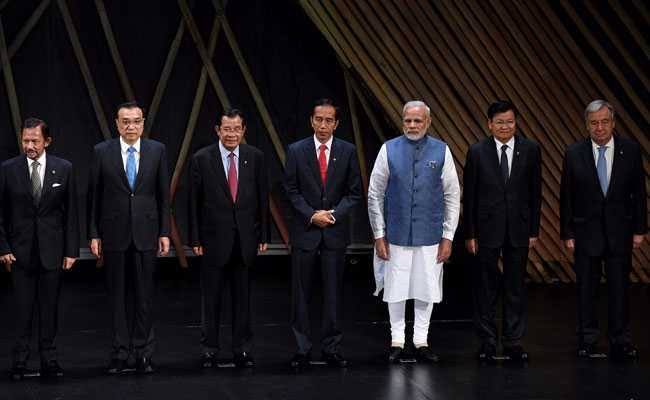East Asia Summit : India Will Pursue Bilateral Pacts With ASEAN Countries

The India-Japan-Australia and India-Australia-France agreements to pursue value chains in the Asia Pacific region are moves that have motivated the interested ASEAN countries that India too is now a priority for establishing close bilateral relationships while maintaining their overall commitment to ASEAN as a community.
In the absence of taking on the Chinese dragon, the ASEAN has been focusing on emphasising ASEAN centrality. While this is a given in almost every ASEAN partner’s statement, the reiteration in various statements gives the impression that the centrality of ASEAN is actually under challenge. This is mainly because China has dealt with the ASEAN countries individually rather than as a bloc.
The Quad is also contacting interested ASEAN countries individually. The way ASEAN operates, it becomes necessary for partners to act separately, like in the Indo Pacific and the Quad.
These detract from ASEAN’s centrality, which is truly not what it used to be even if every dialogue partner continues to mention it.
The East Asia Summit (EAS) is the main summit in the Indo-Pacific region, where all the powers that be gather annually in November. It is a leaders-led forum with informality built into it. It is usually held just after the second ASEAN summit of the year when the ASEAN also meets its dialogue partners, including India. Prime Minister of Vietnam Nguyen Xuan Phuc was the chair of the EAS.
In the virtual format, EAS loses that informality which is its hallmark. Leaders made prepared statements with no scope of informal chatting. As the EAS coincided with Diwali, Prime Minister Narendra Modi had domestic commitments which kept him away and India was represented by the External Affairs Minister S Jaishankar.
Though the main threat in the region is from China, this is rarely discussed openly in deference to ASEAN views.
The promise held out at the September EAS Foreign Ministers meeting that “the free-flowing constructive dialogue on strategic issues amongst Leaders at the EAS in order to reinforce strategic trust and to address common challenges” would strengthen EAS was lost.
The Hanoi Declaration for the 15th Anniversary of EAS has a mere 12 paragraphs. This is because China, backed by Russia, introduced several ideas at the drafting stage which queered the pitch. To remove these, other substantive ideas were dropped, leading to an innocuous document.
This was similar to the 10th Anniversary Kuala Lumpur Declaration of 2015 and does not build on the progress made by the EAS on a variety of functional issues. If this is all that Vietnam as Chair can achieve then next year, when Brunei is the Chair, even less may be expected.
The EAS covers security, economy and functional aspects, which are reflected in the Chairman’s Statement — a summary and not a negotiated document. The Hanoi Declaration devotes several paragraphs to regional issues unique to ASEAN like the meeting with the ambassadors at Jakarta, regional connectivity and the narrowing of development gaps within ASEAN. These documents tend to look more like a donor-donee relationship document than a true partnership of equals, which ASEAN normally seeks.
The situation emanating from the pandemic was the immediate focal point and the Chinese conundrum was ignored by the EAS documents. One has to read between the lines of Dialogue Partner statements, including India’s, to find some criticism of China. The informal consultations at physical summits allowed a greater voicing of concern regarding China.
Traditionally, security aspects have been confined to informal discussions while the functional aspects have dominated documents. This year, the leaders had documents for the regional economy, marine sustainability, dealing with epidemics and the role of women.
Last year, the supporting documents had included leaders’ statements on sustainability, transnational crime and illicit drugs. Over the years, EAS has been looking more at non-traditional threats including illegal fishing, humanitarian assistance, disaster relief (HADR), migration and the like.
The EAS provides ASEAN with an opportunity to become more realistic but internal dissensions over China wither its resolve. Interestingly, Chinese PM Li Keqiang was the one asking ASEAN to conclude the Code of Conduct on the South China Sea.
While the RCEP agreement was signed a day after the EAS, the leader’s statement on the regional economy mentions the WTO but not RCEP as it seeks a transparent, non-discriminatory and stable trade and investment environment to promote regional value chains (RVCs). This is probably in deference to India which has opted out of RCEP but is interested in being a part of the RVCs.
Other areas of interest for India emanating from the leaders documents are regional connectivity with a perceptible shift to the maritime sphere, macroeconomic and financial stability efforts in which India has not so far played a major role.
India has a role in the ideas behind the statement on marine sustainability since it has dealt with illegal fishing and related issues and could become a part of the proposed regional cooperation for mobility of skilled labour and services. These need to be better covered by a reviewed India-ASEAN FTA.
India has an important role envisaged in the statement on dealing with epidemics, both in its ability to provide capacity building and crucial manufacturing bases for pharmaceuticals as part of resilient supply chains for medical supplies in the region. These need to be leveraged directly with ASEAN countries.



